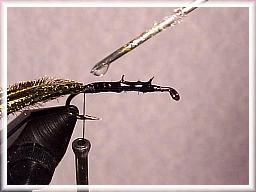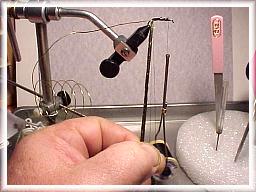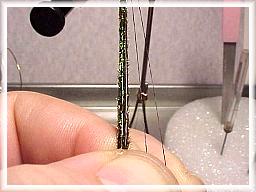Peacock herl is one of the finest fish attracting
materials found in nature. It has an iridescent
quality that fish find very hard, if not impossible,
to resist.
It is also perhaps the most fragile material in
our arsenal!
We can however, with a little extra effort, reap
the rewards of tying with this wonderful material,
and enhance it's durability to a more than acceptable
level.
We start out with a nice tight thread wrap on the
shank of the hook which will be covered by our
peacock herl. (This will also work with Ostrich,
which while not as fragile as peacock, can also
benefit from this technique.)
Now we tie in our herl, and a length of fine wire,
(color of your choice.)
We now use "Daves Fleximent" to coat our thread
base thoroughly.

Grasp the herl with your left thumb and index
finger, bring a length of thread from your bobbin
down along the herl, between your thumb and index
finger and back over the top of the hook. Wind
forward to the appropriate spot. Now let go of
the bobbin with your right hand.

With your left and right hands spin the herl and
thread together between your fingers to make a
sort of rope of herl and thread.

Wind this herl/thread rope forward, adding one
twist for each pass around the hook, and tie off.

Now counter-wind the fine wire forward and tie off.
You can now perform any other operations to complete your fly.
The glue will obviously grasp each of the fibers with
which it contacts. Daves Fleximent is specifically
used as it will penetrate materials and actually bind
them all the way to the wire on the hook. It doesn't
make a fancy finish for heads, but it cements materials
very, very well.
By twisting the herl with the thread, we are actually
doing two things. The first of these is adding strength
(the thread) to the fragile herl, and the second thing
we are doing is causing the herl to "pop" or stand at
attention on the shank.
The wire counter-wrapped up the shank is an extra layer
of protection for the herl and prevents it from unraveling
in the unlikely event that one of the other systems fail.
Herl catches fish, and there is no reason we can not, or
should not, use more herl in our flies. If tied in as shown
here, you will have come as close as we can, at this time,
to a "Bullet Proof" herl fly. Now, bring on the fish!
If you have any tips or techniques, send them along,
most of this material has been stolen from somebody,
might as well steal your ideas too!
~ George E. Emanuel
(Chat Room Host Muddler)
|









